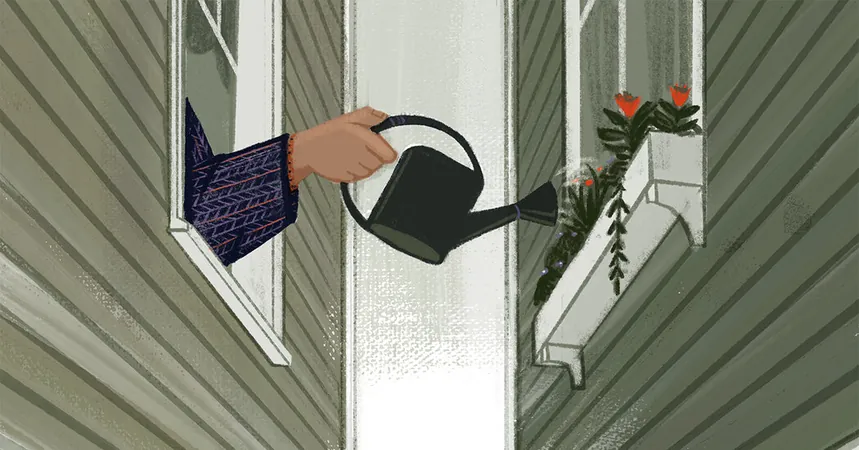
The Complex Caregiving Challenges Faced by Older Unmarried Couples
2024-11-10
Author: Wai
Introduction
As society continues to evolve, so do the dynamics of relationships, particularly among older adults. For a couple that has shared life together for nearly two decades but remains unmarried, navigating caregiving obligations can be fraught with complications, particularly when health issues arise.
Case Study of an Older Couple
Take, for instance, a couple in their 90s living in Florida. Both widowed, they have chosen to maintain separate residences, with the woman’s home becoming a central hub for their relationship. However, recent developments in her health — including memory loss and accidental falls — have raised significant concerns. According to her family psychologist, Jenna Wells, her partner’s supportive presence has been crucial; he assists in her medical appointments and ensures she enjoys companionship.
The Challenge of Aging
Yet, concern looms as they both face the inevitability of aging and the potential worsening of health conditions. The man proposed relocating to a continuing care retirement community, where they could transition from independent living to assisted care as needed. This strategic move could potentially circumvent the risk that arises if she is placed into memory care without him — something he fears could happen if they delay. Unfortunately, the woman's daughter, who holds her power of attorney, supports none of this, creating a rift in the dynamic.
Shifting Relationship Dynamics
This dilemma exemplifies a growing trend: as marital commitments decline among older adults, so do the clear-cut caregiving roles traditionally associated with marriage. According to Susan Brown, a sociologist from Bowling Green State University, without the 'till death do us part' commitment often seen in marriages, the responsibilities of caregiving become undefined.
Census Insights
Census data from 2023 illustrates a significant shift in relationship patterns among older Americans. Only 3.9% of men and 2.6% of women aged 65 to 74 cohabited with partners rather than spouses, up from about 1.7% and 1%, respectively, two decades ago. This trend is especially notable among those 75 and older, where nearly 400,000 individuals are reported to be cohabiting, showing a significant increase.
Factors Influencing Unmarried Partnerships
This rise in unmarried partnerships can be attributed to numerous factors, including longer life expectancies and higher divorce rates experienced in the 20th century. The cultural stigma surrounding cohabitation has also diminished significantly, with baby boomers paving the path for more acceptance of such arrangements. These couples often enjoy many advantages, like maintaining financial independence and sidestepping the complications that accompany marriage, such as asset merging or shared debts.
Legal Preparedness
Despite these benefits, a crucial concern remains: planning for potential healthcare decisions. Research indicates unmarried partners are less likely to have prepared essential legal documents, like advance directives. These issues are particularly pressing when health crises occur, as the absence of formal arrangements can lead to conflicts among partners and family members.
Same-Sex Couples and Proactive Planning
Interestingly, same-sex couples who choose to cohabit often demonstrate proactive tendencies in terms of advance planning, likely due to concerns about family dynamics and potential discrimination. They tend to tackle these issues more directly compared to their heterosexual counterparts.
An Example of Successful Planning
In one compelling example of successful planning, a pair who have been together for 35 years — avoiding marriage to protect Social Security benefits — decided to formalize their legal responsibilities as health issues arose. When one partner developed Alzheimer's disease, the other moved in to provide much-needed care. With their wills and power of attorney arranged, they exemplified a proactive approach to caregiving dynamics in an unmarried partnership.
Future Outlook
Experts anticipate that these cohabiting relationships will continue to rise among older Americans as the social landscape shifts away from the primacy of marriage. The future will likely see a growing acceptance of various living arrangements, challenging traditional norms while emphasizing the importance of clear communication and legal safeguards among partners.
Conclusion
Ultimately, the conversation around caregiving for older unmarried couples is a pressing one — filled with questions of responsibility, loyalty, and the complexities that come with aging in a non-marital partnership. As society adapts to these changing relationship dynamics, it remains essential for couples to engage in open discussions about their wishes and legal preparations, ensuring they navigate their twilight years with clarity, support, and love.




 Brasil (PT)
Brasil (PT)
 Canada (EN)
Canada (EN)
 Chile (ES)
Chile (ES)
 España (ES)
España (ES)
 France (FR)
France (FR)
 Hong Kong (EN)
Hong Kong (EN)
 Italia (IT)
Italia (IT)
 日本 (JA)
日本 (JA)
 Magyarország (HU)
Magyarország (HU)
 Norge (NO)
Norge (NO)
 Polska (PL)
Polska (PL)
 Schweiz (DE)
Schweiz (DE)
 Singapore (EN)
Singapore (EN)
 Sverige (SV)
Sverige (SV)
 Suomi (FI)
Suomi (FI)
 Türkiye (TR)
Türkiye (TR)